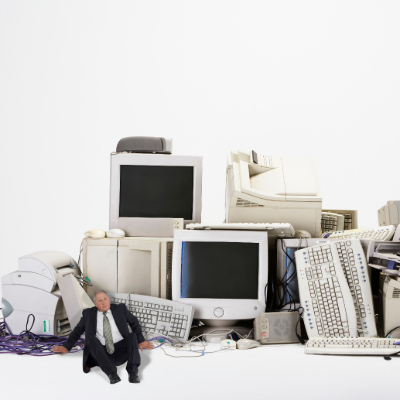
You might want to get as much life as possible out of your technology, but this is often counterproductive. While it might cost serious capital to invest in new computers and servers, even when your current equipment works “just fine,” there will come a day when “just fine” doesn’t cut it anymore. Your outdated hardware comes with all kinds of hidden costs that will slowly leech capital from your business and leave it worse off compared to if you just bought new tech.
Here’s how outdated hardware can hold your business back, particularly in the realms of productivity, security, and your pocketbook.
Productivity Problems
The lack of productivity that comes from technology troubles is notable. Here’s where your team could find themselves falling behind due to your organization’s inability to let go of older equipment.
- Slow performance – Over time, you’ll start to experience symptoms like slow boot times, frozen applications, delayed file transfers, and so on. This leads to significant time wasted every day—time that your team could spend working productively.
- Frequent downtime – You might experience frequent crashes, unexpected reboots, or persistent glitches that lead to downtime, all of which causes lost revenue and operational disruptions.
- Compatibility challenges – Older hardware cannot keep up with the demands of new software, and it might not be compatible at all as time goes on. While you could find manual workarounds, this takes time and effort that could be better spent on upgrading.
- Low employee morale – People can only take so much frustration, and when technology is the main source of frustration, it can be maddening and demoralizing—mostly because something can be done, but isn’t being done. When people aren’t satisfied by their work conditions, they’re more likely to jump ship.
Increased IT Support and Expenses
The ongoing costs associated with your old machine are going to add up, and quickly. Here’s how old technology impacts your bottom line.
- More repair bills – Your devices won’t last forever, and when components start to fail, you’ll feel it in your wallet (and in the frustration of finding replacement parts).
- Greater IT burden – Your IT department will spend more time diagnosing and repairing issues and less time actually doing the important work you hired them to do.
- No end-of-life support – Manufacturers eventually put a stop to support, including security updates, bug fixes, and replacement parts for older models. This puts your business in a tough spot where it has to choose between security vulnerabilities or expensive upgrade costs.
Greater Vulnerability to Cyberthreats
Cybercrime is a problem, and it’s a bigger problem for businesses that are using outdated technology. If you’re using outdated hardware, you’re not using the latest firmware with security patches and updates, which means more opportunity for hackers to take advantage of emerging or existing vulnerabilities, much to your detriment. Many businesses also operate under government or industry-specific regulations, so running outdated systems could create compliance issues as well.
Higher Costs
There are times when the biggest issues are overlooked, and outdated hardware is one such issue. When you rely on legacy infrastructure for your IT, you’re placing a bottleneck in your growth, and it will hinder your ability to adopt new technologies, scale operations, or integrate with more modern cloud-based tools.
Plan to Upgrade Now
You can overcome these issues with outdated hardware by working with GeekBox IT. We’ll work together with you to build out a plan to upgrade to more modern equipment, and we’ll help you do it in an affordable way. Learn more by calling us at (336) 790-1000.
